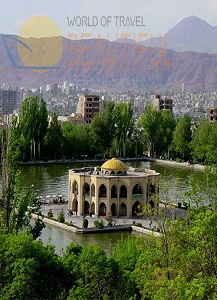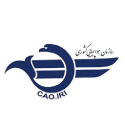East Azarbayjan
Main Townships: Ahar, Hashtrood, Marand, Maraqeh, Mianeh, Tabriz, etc. Main Attractions: Arg Mosque, Babak Castle, Eil Goli Ediface, Kabood Mosque, Kandowan Village, Orumieh Lake, Sahand Summit, Saint Stepanous Church, etc
Townships, East Azarbayjan
Ahar ( Arasbaran )
The mountainous township of Ahar can be said to be as one of the oldest sections of Azarbayjan. The center of which being the city of Ahar located 103 km. northeast of Tabriz. Ahar experiences cold and snowy winters and moderate summers. Dense forests cover a major portion of its valleys and the Ahar Chay River flows through this vicinity. This sector being of importance both politically and from the military point of view has proved to be historically sound too. In the early 3rd century AH., this territory was for twenty years one of the bloodiest battlefield between Babak Khorram Din and the Arab warriors.
During the reign of the Qajar dynasty, the city of Ahar was the center of command of Abbas Mirza (the Crown Prince of Fathali Shah) being the commander of Iranian forces during the Iran-Russian war.
Bonab
Bonab is situated southwest of Tabriz and the east coast of the Orumieh Lake. Its capital city Bonab is approximately 113 km. from Tabriz and 13 km. from the city of Maraqeh. Bonab means 'A land in water' or near water. This city was a flourishing one before the Mongol attack, but owed its rebirth to the Safavid era. Its historical, economical and social advancement was influenced mainly by the city of Maraqeh.
Bostan Abad
This township lies in the skirts of the Sahand Mountains with cold winters, moderate springs and summers. The capital is Bostan Abad which lies 55 km. east of the city of Tabriz. Furthermore, Bostan Abad is located north of the archaic and historical city of Ojan. Due to its ideal environment and climate Ojan was said to be the summer residing quarters during the period of the Ilkhanan Mongol, which then by the passage of time was totally ruined.
Haris
The township of Haris is located in the eastern sector of the province. Haris is 98 km. from Tabriz. It is one of the most fertile regions in this province. To the north of which are the mountains of Qooshadaq, Bozqoosh and Sahand. The summers of Haris being moderate and winters are cold. Haris is one of the historical regions of the province, and according to the records during the reign of Qazan Khan Mongol was extremely a prosperous area. A few ancient relics are found here too. Carpet weaving in Haris and in its surrounding rural areas have won both national and international fame.
Hashtrood
This township is to the southeast of Tabriz, its capital city being Hashtrood is 122 km. far from Tabriz. This vicinity has a rural setting with 8 important rivers flowing through this area ( as its name suggests Hasht means eight and Rood means river). Hashtrood has a variable climate, a part of its western sector, being mountainous and cold, part of its central portions are moderate. The remnants of the famous castle of Zahak is situated here, and earthenware related to much before the birth of Christ have been found in this territory. This castle was in use during the Esmaili reign.
Jolfa
This township is in the northwest of the province and the Aras River flows through the north of which, near the borders of Iran and the Republic of Azarbayjan and Armenia. Jolfa being the capital city of the township, located 150 km. from Tabriz. It has warm summers and moderate winters due to its relief, rainfall and vegetation are scanty.
Kalibar
This mountainous township is located to the northeast of this province. Its capital city Kalibar being situated in a beautiful valley, 45 km. from Ahar and 148 km. from Tabriz. Being under the influence of climatic conditions from the Caspian Sea, most of its higher areas are usually foggy. Kalibar also has forest areas and the Aras River flows through the north of this vicinity. The famous peak of Babak or Jomhori stands at an altitude of 2,600 m. west of Kalibar.
Malekan
The township of Malekan is located in the south-western limits of the province of East Azarbayjan and west Azarbayjan and the province of Kurdestan within 10 km. of the Lake Orumieh. In the south of Malekan is the remains of the historical city of Leilan. Malekan was a thriving and flourishing region due to its position in the communication network between Tabriz and East Azarbayjan to Kurdestan and West Azarbayjan. Further more, its fertile soil proves excellent for gardening and agricultural purposes. The main agricultural products being dried fruits, fruits, vines and cereal products. Its weather is cold in winters, warm and moderate in summers.
Marand
Marand lies northwest of the province and is semi mountainous. The historical city of Marand is 71 km. from Tabriz, having cold winters and moderate summers. Marand has been famous from long past such as the Assyrian and Kaldeh when it was a center of importance. It is narrated as being a place of burial of the prophet Noah. Its name being derived from the Pahlavi word Madvand meaning the 'living place' of the Medes. This area has also been subject to upheavals in the past.
Maraqeh
The township of Maraqeh is located to the south of Tabriz and in the southern slopes of the Sahand mountains. The historical city of Maraqeh is 126 km. from the center of the province and has variable climate, such as in the higher areas being of mountainous type, and in the regions around the Orumieh lake being warm. Throughout history, this city has been brought plenty of upheavals such as the battles of Babak Khorram Din against the Arabs. In the year 628 AH., when it fell into the hands of the Mongols, in the year 656 AH. become the center of command under Hollakoo Khan Mongol. The remains of the famous observatory which is reputed in the world stands here from these times.
Mianeh
Mianeh lies in the eastern most region of the province between the Bozqoosh and Qaflan Kooh mountain ranges. Mianeh stands 170 km. southeast of Tabriz. It has a warm Mediterranean climate with a maximum annual temperature of 19° C on an average.
Sarab
Sarab is located east of the province of East Azarbayjan and towards the province of Ardabil. Its capital, Sarab city is 636 km. from Tehran, 130 km. from Tabriz to the east of Bostan Abad. This township resting amongst the high mountains of Bozqoosh and Sahand. It has a mountainous and moderate climate, with extremely cold winters and pleasant summers. Sarab being one of the oldest towns of this province bears ancient monuments. Due to the surrounding volcanoes, mineral water is in abundance.
Shabestar
The township of Shabestar is northwest of Tabriz and its capital city Shabestar is 60 km. northwest of Tabriz. It is en route on the railway line running between the city of Tabriz and Turkey, and is a part of the hilly region of Mishoo and northwest of the Lake Orumieh. It experiences hot temperate summers and cold, moderate winters. During the Safavid era the famous passage of Tabriz - Tarabuzan passed through this city. Shabestar is noted to be one of the oldest cities of the province of East Azarbayjan. Reputed personalities such as Sheikh Mahmood Shabestari, Sheikh Mohammad Khiyabani and Mirza Ali Akbar Mo'jez Shabestari are from this area.
Tabriz
The city of Tabriz is situated 619 km. northwest of Tehran and 150 km. from the borders of Iran and the Republic of Azarbayjan. This city is generally cold but due to its environment the climate is extremely pleasant. Rivers such as Ajy Chay, Liqvan Chay, Maidan Chay and Soofian Chay flow through this area. In an inscription related to Sangar II one of the Assyrian rulers 714 BC, the name of Tabriz has been mentioned in the 3rd and 4th centuries AD when the city of Tabriz was of great importance.
For the first time in the 4th century AH., the Raavadian family proclaimed Tabriz as their capital. During the said period and the Mongol reign, Tabriz experienced many earthquakes causing it to become a ruined city. But after the Mongol conquests this city was made capital by 'Abaqakhan' of the Ilkhanan. During the reign of 'Mahmood Qazan' (694 AH.) the city thrived . Mosques such as Alishah, Robe Rashidy, and Shonab Qazan were constructed during this period. During the Safavid dynasty Tabriz was the capital of Iran. The Kabood Mosque is a relic from the time of the Turkemans. In later centuries Tabriz has been the seat of great warriors facing the Ottomans and Russians.
Personalities such as Sattar Khan and Baqer Khan in their fight against despotism is on historical record. In the year 1911 AD., Sheikh Mohammad Khiyabani (one of the clergymen) revolted against the colonialist policies of the British government. The Islamic revolution owes its success partly, because of the participation of the people of Tabriz and their heroic deeds.
Palaces and Edifices, East Azarbayjan
Eil Goli Edifice, Tabriz
The former Shah Goli or the present Eil Goli (the Shah's pool) is one of the recreational areas of Tabriz and Iran located to the north east of Tabriz. The initial date of construction is not specified but this edifice has been repaiblack in the year 1970 according to the former lines of architecture.
Khajeh Nasir Observatory, Maraqeh
This famous observatory was constructed in the year 657 AH. during the rule of Hollakoo Khan under the orders of the great Iranian scholar Khajeh Nasiroddin Toosi. Archeologists have excavated sections of this aggregate, the most important of which being the central tower and library besides other evidences of this observatory.There is also a historical cave in this vicinity from the Sassanian era known as the Talib Khan Cave.
Robe Rashidy Edifice, Tabriz
These are the remnants of the ancient edifices from the period of the Eilkhanians. Robe Rashidy was the center of scholars and the learned people of those times.
Shahr Dary ( Municipality ) Palace, Tabriz
This building is located in the downtown of Tabriz in the famous clock (Sa'at) square. This structure was constructed in the year 1933 AD. under German supervision before World War II. The stony edifice is constructed on a ruined and ancient graveyard. There is a tower with a four sided clock on this building and at present is the municipality building of Tabriz.
Old Mosques, East Azarbayjan
Ahar Jame' Mosque, Ahar
The said mosque, dates back to the Saljuqi and Atabakan periods and is an excellent and interesting piece of architecture. In the inscriptions here the date (1052 AH) can be noted.
Ark Mosque, Tabriz
This great edifice is the remnants of the mosque built in the years 716-724 AH., by the Minister of Soltan Mohammad Khodabandeh and Abu Sa'eid Bahador Khan. In those times it was tile-worked with marble columns and inscriptions. Later on it came down to ruins. In the year 1320 AH. (1941 AD), its courtyard was turned into a public park known as Baq-e-Melli or national garden. To which a few buildings such as official buildings and a hall have been added. But these in recent years have been demolished and the courtyard is now used as a place for Friday prayers in the city of Tabriz.
Asnaq (Sangi) Mosque, Sarab
This mosque is located in the village of Asnaq. It has stone pillars and beautiful inscription. This mosque is one of the relics of the 8th century AH.
Jamal Abad (Sangi) Mosque, Sarab
The mosque of Jamal Abad village has fine, majestic pillars reaching to a height of 536 cm. adorned with decorative designs. The ceiling of this mosque is made of wood. The wood works seen here can be related to the Teimoorid and Safavid periods.
Kabood (Goey) Mosque, Tabriz
This structure is the remnants of the Turkemans in the year 870 AH. The mosque was destroyed by the earthquake in the year 1192 AH. and only the gateway remained as an excellent piece of architecture. The building of the mosque became under interest in 1310 AH. and in 1318-1319 Shamsi (1939-1940) and after the Islamic Revolution, its northern facade was reconstructed.
Marand Jame' Mosque, Marand
Most probably originally this mosque was a fire-temple in Sassanian era. Due to upheavals this fire-temple was converted into a church. After the victory of the muslims, the same was changed into a mosque in the 3rd century AH. This mosque has oriental and spectacular architecture.
Mehr Abad Mosque, Bonab
This mosque is from the Safavid era and has excellent oriental architectural display with numerous pillars.
Molla Rostam Mosque, Maraqeh
This mosque has fine and suitable areas for nocturnal prayers both in summer and winter. From the architectural point of view including artistic measures it is extremely interesting. This structure is one of the very first to be erected during the reign of Shah Tahmasb end of 10th century AH.
Sarab Jame' Mosque, Sarab
This mosque is one without minarets is a relic of the 9th century AH, and has three altars, one of which is most beautiful with spectacular tile works.
Tabriz Jame' Mosque (Jomeh Mosque), Tabriz
It is one of the historical mosques of the area. Throughout the ages this mosque has flourished and today is the seat of theology and place for religious ceremonies.
Tark (Sangi) Mosque, Mianeh
In Tark Village there is an old mosque with external facade adorned with sculptublack stones.
Tasooj Jame' Mosque, Shabestar
It is one of the ancient religious relics. This mosque has 24 pillars and 35 brick arches. On its entrance there is a stone on which an inscription with 'Tholth' script has been written which belongs to 10th century AH. of Safavid era.
Other Old Mosques, East Azarbayjan
Besides the above there are numerous other mosques in the area, such as hajat mosques in Tabriz, Ajabshir Jame Mosque in Ajabshir, Ainaly Mosque in Tabriz, Mianeh Jame Mosque in Mianeh, etc.
Special Villages, East Azarbayjan
Kandowan Village, Tabriz
This village lies 62 km. southwest of Tabriz and 22 km. south of Oskoo. From the architectural point of views this village is interesting, as the settlements are rocky dating back to the 7th century AH. or even the pre-Islamic period. These 'houses' resemble caves, being 'dug out' in the mountains and therefore are reputed worldwide. Mineral water in this area is also used for treatment of diseases. There are various other interesting villages in the province having specific architectural features.
Oshtobin Village, Kalibar
This village is located on the borderline of Iran and the Republic of Azarbayjan, 14 km. from the Aras River. With its pleasant climate and natural beauty it stands in importance to the village of Kandowan in this province. A few ancient engravings can be observed here and the people converse in the language of Tati.
Sis Village, Shabestar
This village lies 14 km. from Shabestar. An engraving (on stone) can be observed on one of the hillocks west of it. Here ancient graves are also evident.





